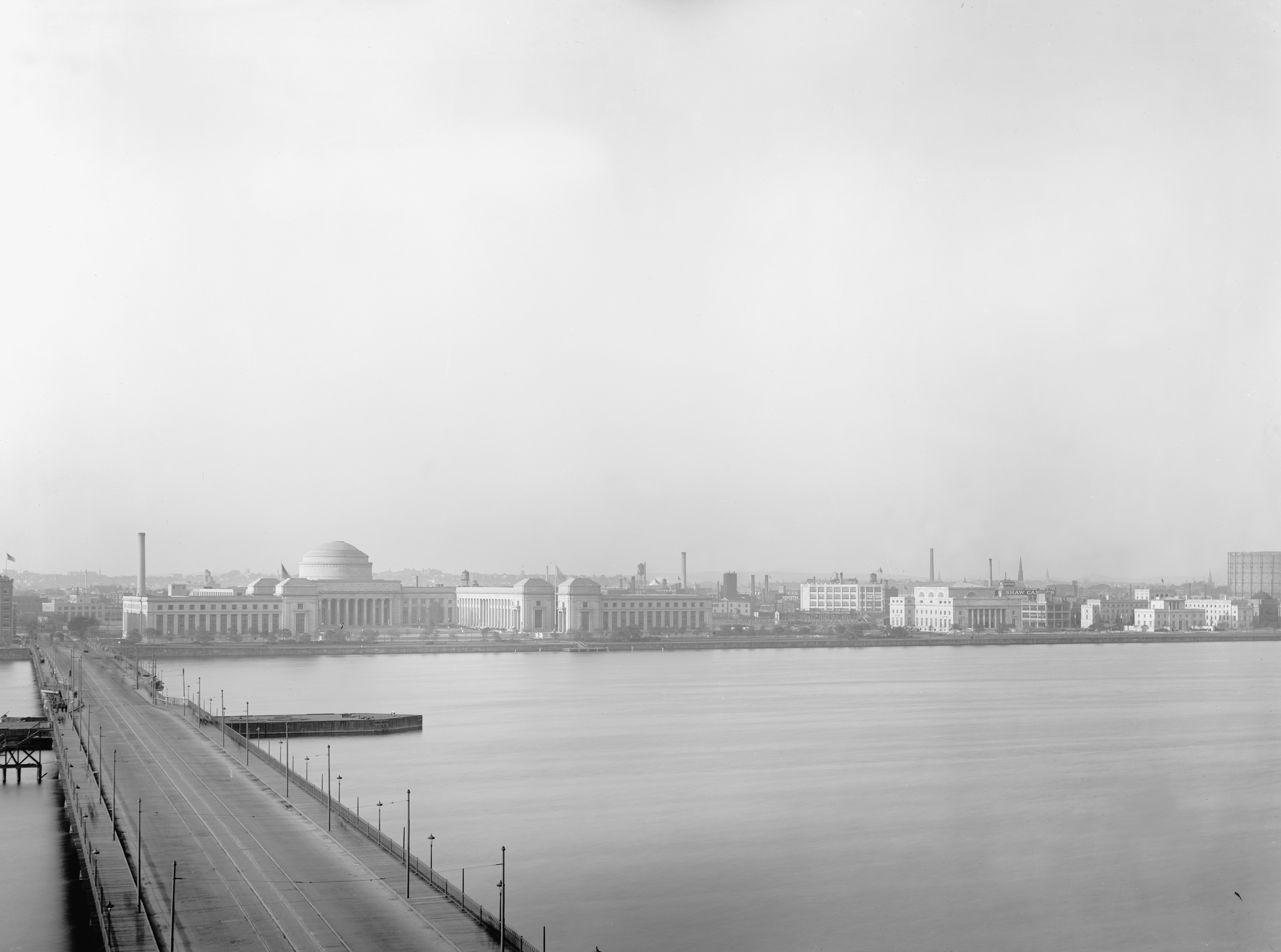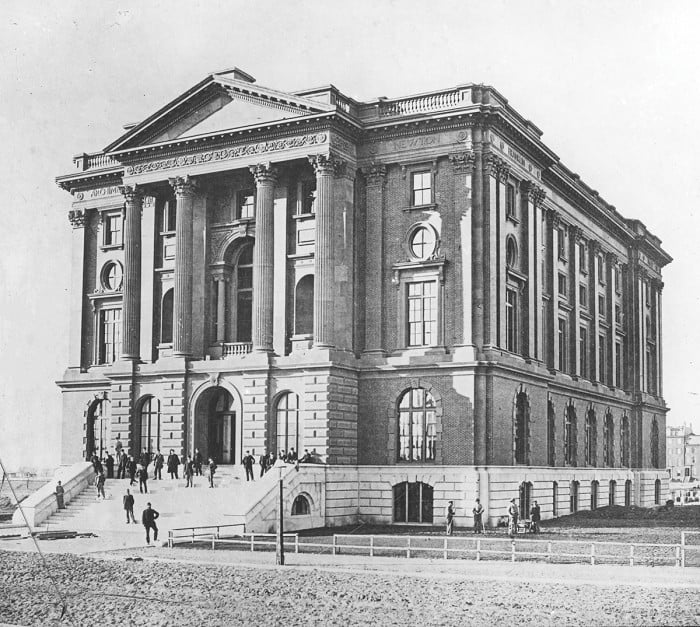The Move That Shaped MIT

If MIT had not moved from Boston to Cambridge 100 years ago, the Institute as we know it would not exist. Had it remained in the Back Bay, which was already bursting at the seams, it faced almost certain stagnation—and it might not have survived at all. But the new campus, known as “New Technology,” did more than provide a bigger footprint with more classrooms and laboratories. The move also began MIT’s transformation from a pioneering and highly regarded school of engineering into an internationally renowned science-based research university.
William Barton Rogers had always expected that MIT would grow. In some of his earliest writings he boldly asserted that his proposed school would “expand into a great institution” and “soon overtop the universities of the land.” Following MIT’s incorporation in 1861 and his successful (if fraught) campaign to raise the $100,000 required by the state to begin building, Rogers had an architect design a vastly larger structure than might have been rationally justified. (There were 15 students at the start, but the main lecture hall was designed to accommodate 400.) As it turned out, Rogers had been right to be so ambitious. Over the next half-century, MIT grew rapidly. By the turn of the century, enrollment had swelled to nearly 1,300 students.

Boston had also grown. The city’s population nearly quadrupled from 177,840 in 1860 to 670,585 in 1910. Once a marsh on the outskirts of Boston, the Back Bay was by then completely filled in—and filled up with homes and businesses. Copley Square had become the intellectual hub of the city, home to MIT, the Boston Society of Natural History, the Museum of Fine Arts, the Boston Public Library, Harvard Medical School, Trinity Church, and Old South Church. Yet by 1900, most of these institutions were facing severe space constraints, perhaps none more so than MIT.
Beyond dealing with overcrowding and general building deterioration, MIT also faced the more fundamental challenge of major new developments in science and technology. Consider that when classes began in 1865, the atom was a provisional concept, Mendeleev was still formulating his periodic “system,” and Maxwell’s equations and Darwin’s ideas about evolution were brand new. Half a century later, these advances had all been incorporated into the curriculum. Meanwhile, a remarkable new era in physics had unfolded, introducing such concepts as radiation, relativity, and quantum theory. Electrical engineering had also taken off, and aeronautical and chemical engineering were exciting new disciplines that hadn’t existed when MIT was founded.
Teaching all this required different kinds of classrooms and more labs. At the same time, some faculty members were doing significant research in support of industry and government, which added to the demand for lab space. MIT had also begun offering graduate courses; by 1908, when it awarded its first PhD degrees, 189 students were pursuing graduate studies. But space constraints limited the Institute’s ability to accommodate graduate work. It was also clear that some new research projects required specialized equipment, such as wind tunnels and tow tanks, that would impose still more space demands.
These challenges had seemed so insurmountable to MIT’s fifth president, Henry Pritchett, that he and the MIT Corporation thought merging with Harvard University was the only viable solution, despite vehement opposition from alumni and faculty. But the plan to transform MIT into Harvard’s new school of engineering was scuttled when the Massachusetts Supreme Judicial Court ruled in September 1905 that under the terms of its charter from the state, MIT could not sell its Boylston Street property to pay for new Harvard engineering facilities in Allston. Having failed in this effort, Pritchett offered his resignation in 1906.
It was a perilous moment. Although the debate about the merger had clarified MIT’s priorities, the Institute was short on money as well as space. MIT depended on tuition for most of its income. Almost every year since its founding, it had run a deficit, which placed real limits on salary increases and precluded building a dormitory and other facilities conducive to student life. In his President’s Report of 1907, acting president Arthur Noyes despaired that raising tuition had the effect of “shutting out a large group of promising young men.”
The Corporation had great difficulty convincing anyone to take on the many challenges of leading the Institute. At a February 1908 dinner at the Manhattan home of Columbia professor Ernest Fox Nichols, MIT found its man. The guest of honor, Richard Cockburn Maclaurin, had just taken a post as a physics professor at Columbia, having moved his family from New Zealand to New York. Only 37, he was brilliant, broadly educated, and, to the chagrin of Columbia’s president, ready to move beyond physics. His compelling ideas about higher education prompted dinner guests from MIT to immediately recommend him to Noyes. Maclaurin became the unanimous choice of the Executive Committee of the MIT Corporation, which that November offered him the presidency and an invitation to “think Technology, work Technology, dream Technology.”
Even before his inauguration in May 1909, Maclaurin knew that MIT had to move. “In every case where an institution has outgrown its equipment, a change to a new site and new buildings has been a turning point in its career,” he told reporters when his appointment was announced. “Such a change has often converted a comparatively obscure institution … into an important one.”
Between 1909 and 1916, Maclaurin tirelessly led the process of imagining a “New Technology.” He started by working with the Corporation, faculty, and alumni to define the goals—ample space for labs and teaching, flexibility to accommodate curriculum expansion and new research, and dormitories, athletic facilities, and social spaces to promote a more well-rounded education. After considering 23 potential sites, he zeroed in on vacant land across the Charles that he had spied during his very first visit to Cambridge in 1908.
Then there was the matter of finding a way to pay for it all. In October 1911, MIT inked a deal for the land for $750,000, mainly using a $500,000 gift from industrialist Coleman du Pont, Class of 1884. But building on that land would require a major investment. In 1912, Maclaurin met with Eastman Kodak founder George Eastman—long an admirer of MIT, the alma mater of several of his top employees. One week later, Eastman pledged “two and one-half millions of dollars” for construction of the new campus. It was time to move from dreaming about the New Technology to designing and building it.
Determined to make the best use of the new space, Maclaurin tapped into the MIT community’s expertise. Alumnus and civil engineering pioneer John Ripley Freeman proposed a radical design, based on his study of European universities and American factories, that emphasized flexibility and sited departments in adjoining spaces instead of separate buildings. Maclaurin prized Freeman’s exhaustively researched ideas about functionality, but he also wanted the face of the new campus to reflect the importance of the Institute’s work. The ultimate design melded Freeman’s functional vision with the equally compelling vision of architect William Welles Bosworth, another alumnus. Crucial to this effort was the creative design work of two more alumni, Charles Stone and Edwin Webster. Their firm, Stone & Webster, built the new campus, and its engineers worked out the countless details and the not insignificant engineering challenges required to marry the ideas of Freeman and Bosworth, divvy up the interior space among departments, and build and equip what was then one of the world’s largest concrete structures.
Construction got under way in 1913, and in June of 1916, MIT celebrated the nearly completed campus with three days of dedication events that received international press attention. Highlights included
a water “fête,” a huge open house (with the first public display of the Wright Brothers’ 1903 Flyer), a pageant with a cast of more than 1,000, and a banquet attended in person by Orville Wright and Alexander Graham Bell—and virtually by alumni in 34 cities through a special telephone hookup arranged by American Telephone and Telegraph. (It took more than 300 pages in the July 1916 issue of Technology Review to describe it all.)
Classes began on campus that fall, and as Maclaurin had hoped, MIT’s graceful dome and Beaux-Arts façade projected the importance of science and technology in modern life. The design of the new campus would have a profound impact on the Institute’s evolving culture. New Technology’s flexible academic spaces, its interconnected corridors, and the close proximity of the departments would foster interdisciplinary work and encourage a new and special kind of intellectual entrepreneurialism. The buildings’ ready adaptability to changing priorities would force faculty to demonstrate that their work—and use of space—was “MIT-worthy,” pushing them to focus on solving important problems.
In the end, the move reinvigorated and enlarged William Barton Rogers’s vision of a practical education combining laboratory and lecture hall. MIT’s new aim was to “strengthen American industry at the base by fixing it firmly on the solid rock of science,” Maclaurin said at the dedication. “Our prosperity as a nation, perhaps even our very existence, must depend on the extent to which we assimilate this doctrine.”
Maclaurin had begun his tenure at MIT by observing: “A bold policy, a courageous policy of trust in the future, is the wise one. To advance rapidly, an institution must not be afraid of its own development.” Having been bold, he stood before the crowds gathered in 1916 to dedicate “a noble group of buildings to a noble purpose,” and ushered in a new era for MIT.
Deborah G. Douglas, director of collections and curator of science and technology at the MIT Museum, curated the exhibit “Imagining New Technology: Building MIT in Cambridge,” which is at the MIT Museum through August 2016.
Keep Reading
Most Popular
The Biggest Questions: What is death?
New neuroscience is challenging our understanding of the dying process—bringing opportunities for the living.
Google DeepMind used a large language model to solve an unsolved math problem
They had to throw away most of what it produced but there was gold among the garbage.
Unpacking the hype around OpenAI’s rumored new Q* model
If OpenAI's new model can solve grade-school math, it could pave the way for more powerful systems.
10 Breakthrough Technologies 2024
Every year, we look for promising technologies poised to have a real impact on the world. Here are the advances that we think matter most right now.
Stay connected
Get the latest updates from
MIT Technology Review
Discover special offers, top stories, upcoming events, and more.